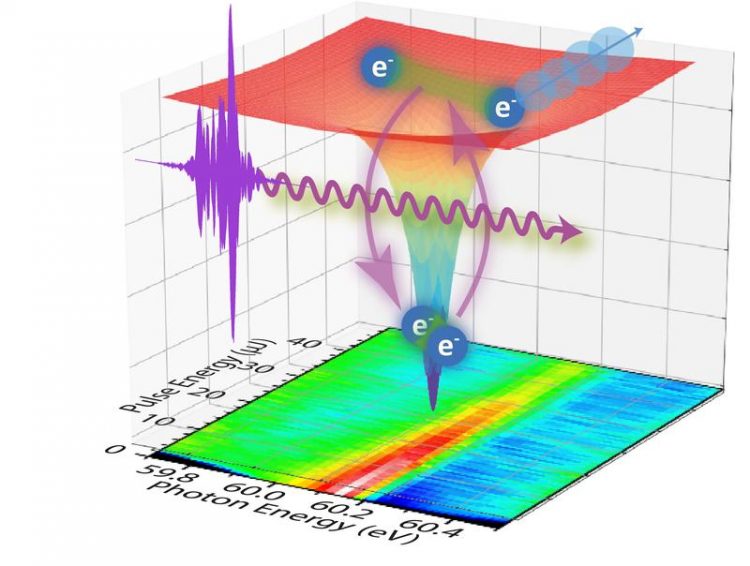Distorted Atoms

Schematic illustration for the powerful excitation of an electron pair (blue) in the helium atom by an intense ultrashort XUV laser pulse (violet). Graphics: MPIK
An international team led by physicists from the MPIK reports on new results for efficient two-electron excitations in helium driven by strong and ultrashort extreme-ultraviolet (XUV) laser pulses [1]. Such doubly excited states are short-lived, decaying in just a few femtoseconds (10⁻¹⁵ seconds) via autoionization: one electron falls back into the ground state while the other one escapes from the atom.
To achieve a significant population of this state, the rate of excitation has to be faster than the decay rate. It is like pumping water into a reservoir which has a significant leak.
This experiment has been performed at the Free-Electron Laser in Hamburg (FLASH), which delivers intense XUV laser pulses with a sufficiently short interaction time. Theoretical modelling predicts an efficient excitation of the electron pair by such pulses.
Temporarily, the excited-state population may even exceed that of the ground state, creating a population inversion. This laser-controlled quantum dynamics with two active electrons manifests itself in a significant modification of the XUV light absorption, which has been observed in the experiment (see lower part of Figure).
In a second experiment at FLASH, the team around the Heidelberg physicists carried out XUV-pump XUV-probe transient absorption spectroscopy of doubly charged neon ions [2]. Here, the free-electron laser is used both for the production of the ions as well as for the spectroscopy.
It reveals a nonlinear coherence spike on a few-femtosecond timescale which relates to the coherence time of a free-electron laser pulse. It thus represents a key step towards the implementation of two- and multidimensional spectroscopy approaches, even for statistically fluctuating free-electron lasers and gas-phase samples. The scientific key result of this experiment was the direct measurement of shifts of atomic energy levels induced by nonlinear interaction with the intense XUV laser.
Altogether, these results open up new routes to explore extreme light-matter interaction and for element-specific quantum control with resonant nonlinear optics at short wavelengths.
Tuning the distortion of specific chemical elements within molecules could, in the future, revolutionize our way of thinking about chemistry.
Dr. Christian Ott
Tel: (+49)6221-516-577
E-Mail: christian.ott@mpi-hd.mpg.de
Dr. Thomas Ding
Tel: (+49)6221-516-332
E-Mail: thomas.ding@mpi-hd.mpg.de
Prof. Dr. Thomas Pfeifer
Tel: (+49)6221-516-380
E-Mail: thomas.pfeifer@mpi-hd.mpg.de
[1] Strong-Field Extreme-Ultraviolet Dressing of Atomic Double Excitation
Christian Ott et al.
Physical Review Letters 123,163201 (2019), DOI: https://doi.org/10.1103/PhysRevLett.123.163201
[2] Nonlinear Coherence Effects in Transient-Absorption Ion Spectroscopy with Stochastic Extreme-Ultraviolet Free-Electron Laser Pulses
Thomas Ding et al.
Physical Review Letters 123, 103001 (2019), DOI: https://doi.org/10.1103/PhysRevLett.123.103001
https://www.mpi-hd.mpg.de/mpi/en/research/scientific-divisions-and-groups/quantu… Division Pfeifer at MPIK – Excited Atoms and Molecules in Strong Fields
https://flash.desy.de/ Free-Electron Laser FLASH
https://physics.aps.org/synopsis-for/10.1103/PhysRevLett.123.163201 Distorting Helium Atoms with XUV Light – Physics Synopsis
Media Contact
More Information:
http://www.mpi-hd.mpg.deAll latest news from the category: Physics and Astronomy
This area deals with the fundamental laws and building blocks of nature and how they interact, the properties and the behavior of matter, and research into space and time and their structures.
innovations-report provides in-depth reports and articles on subjects such as astrophysics, laser technologies, nuclear, quantum, particle and solid-state physics, nanotechnologies, planetary research and findings (Mars, Venus) and developments related to the Hubble Telescope.
Newest articles

First-of-its-kind study uses remote sensing to monitor plastic debris in rivers and lakes
Remote sensing creates a cost-effective solution to monitoring plastic pollution. A first-of-its-kind study from researchers at the University of Minnesota Twin Cities shows how remote sensing can help monitor and…

Laser-based artificial neuron mimics nerve cell functions at lightning speed
With a processing speed a billion times faster than nature, chip-based laser neuron could help advance AI tasks such as pattern recognition and sequence prediction. Researchers have developed a laser-based…

Optimising the processing of plastic waste
Just one look in the yellow bin reveals a colourful jumble of different types of plastic. However, the purer and more uniform plastic waste is, the easier it is to…


